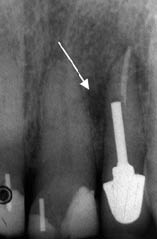(b) 
A periapical radiograph of the 22 revealed a radiolucent area in the mid-root region which was most likely associated with a post perforation (Figure 5.4.1b). The 21 and 23 were responsive to electric pulp and cold tests.
Diagnosis and treatment planning
The diagnosis reached was chronic periradicular periodontitis with suppuration associated with an existing root canal treatment and perforation.
What was the most likely cause of this endodontic problem?
The periradicular periodontitis was most likely to be associated with bacterial leakage through a post perforation at the mid-root level of tooth 22.
What is a root perforation?
Root perforations are pathologic or iatrogenic communications between the root canal system and the external root surface (Table 5.4.1). This communication compromises the health of the periodontium as the perforation injury leads to bacterial leakage in the area.
Table 5.4.1 Summary of causes of root perforations
| Causes of perforations | |
Pathological
|
|
Iatrogenic
|
|
What were the treatment options in this case?
- Root canal retreatment of 22 including perforation repair.
- Periapical surgery of 22 in order to repair the perforation (treatment of choice in this case).
- Extraction of 22, and subsequent restoration of the space with a fixed bridge or an implant retained crown.
Attempting to remove the post and crown may result in a root fracture. Non-surgical repair of the perforation may have proved difficult, and there would always be a possibility that in order to gain good access, a surgical flap would have to be raised. A surgical approach would mean that the crown could be retained. The disadvantage of the surgical approach would be the difficulty of creating a bacteria-tight seal in the region of the perforation; therefore, the post would need to be resected away to create room for the perforation repair material.
Stay updated, free dental videos. Join our Telegram channel

VIDEdental - Online dental courses


